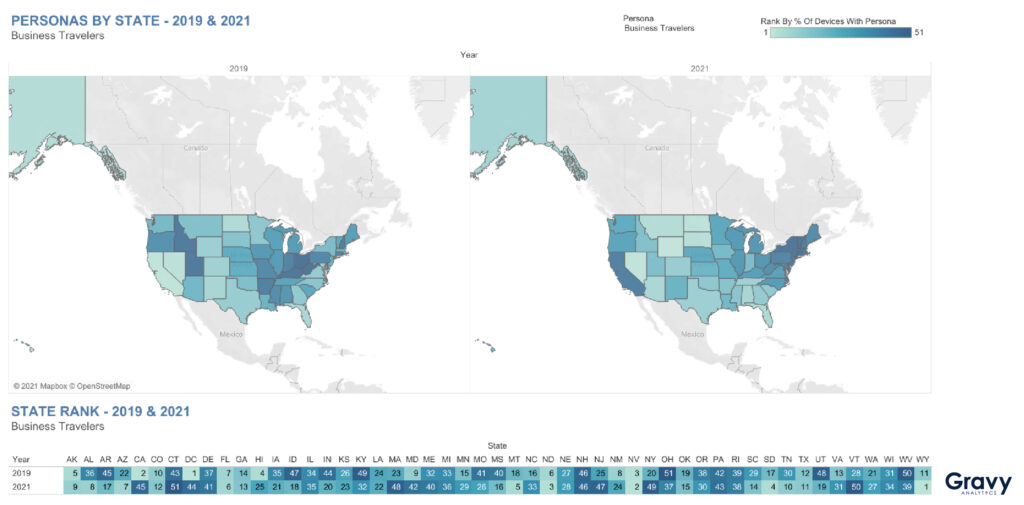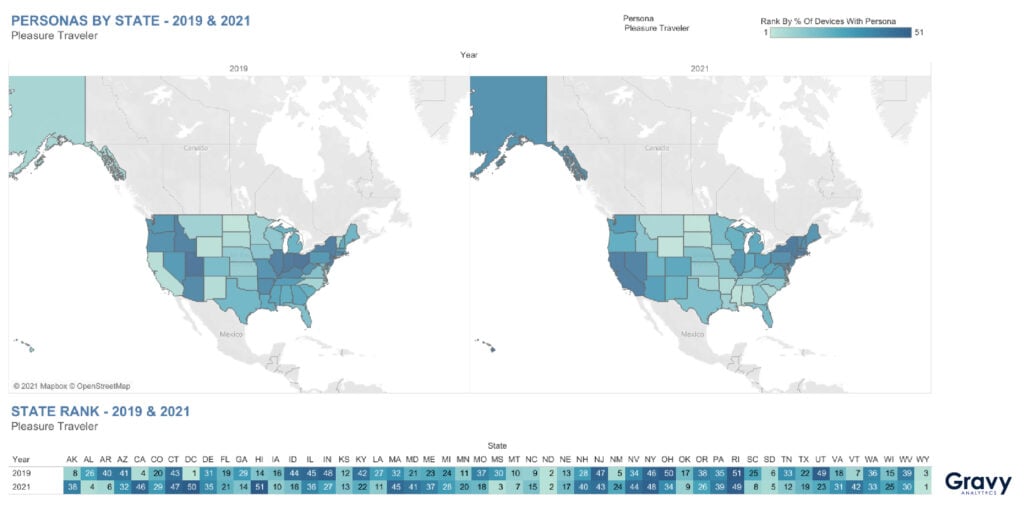Are Business and Leisure Travelers Making a Comeback in the U.S.?
September 15, 2021

In 2020, business travel halted due to the COVID-19 pandemic. Now, business travel is slowly starting to pick back up, even as new coronavirus variants emerge. In contrast, leisure travel remained popular during the pandemic as more companies embraced a work-from-home culture that allowed their employees to work remotely from anywhere. This emerging consumer trend of ‘bleisure’ travel isn’t going away anytime soon and, as vaccination rates increase, more people will start planning their next vacation.
To find out exactly how COVID-19 has impacted consumer travel habits, we analyzed the personas of consumers interested in business travel (Business Travelers) and leisure travel (Leisure Travelers), respectively. We then ranked the 50 states and Washington, D.C. in order of persona prevalence. If a state had a higher percentage of residents fitting the persona, we gave it a higher rank on the list. Then we compared each state’s rank in 2021 to 2019 to see exactly how consumer personas in each state have changed.

Business Travelers in the U.S.
D.C. and California ranked #1 and #2 in terms of Business Travelers in 2019, and saw the biggest decreases in the persona in 2021. In contrast, Wyoming, Nevada, and North Dakota, which also had high percentages of Business Travelers in 2019, remained near the top of the list. Which states are home to the fewest Business Travelers? In 2021, residents of most states in the Northeast are far less likely to be traveling for business. These changes more than likely reflect the impact of state and local COVID-19 regulations on residents’ travel habits.

Leisure Travelers in the U.S.
Some areas of the U.S. now have far fewer Leisure Travelers than in 2019. Consumers living in D.C., California, and Hawaii are all far less likely to engage in leisure travel in 2021. This is most likely due to local regulations and people opting to take stay-at-home vacations due to the coronavirus. In Hawaii’s case, officials have long been telling vacationers not to come due to increased coronavirus cases on the mainland; it makes sense that many residents of the state would stay home as well. Much of the Northeast also experienced a decrease in consumers interested in leisure travel.
Where are Leisure Travelers now? Consumers in Arkansas, South Carolina, Tennessee, Mississippi, and Utah are all more likely to be Leisure Travelers in 2021. North Dakota, which ranked #2 in 2019, remained in the same spot for 2021.

Location Intelligence for Travel Trends
Travel trends are going to continue to change, and companies need to keep up with changes in consumer travel habits. With location intelligence, businesses can stay up-to-date on consumer trends and use those insights to stay competitive in their respective industries.
The re-emergence of business travel depends on the reopening of offices and vaccination rates. Some companies have gone fully remote and no longer require their employees to travel. Once offices reopen, there may be a return to business travel, but companies might be more selective about which employees need to travel for their jobs.
Leisure travel will also rely heavily on vaccination rates and the emergence of coronavirus variants. The majority of Americans will likely opt to travel within the U.S. or to simply take a staycation, rather than choose to go aboard for vacation.
Based on our data, we predict that the percentage of Leisure Travelers and Business Travelers will increase in areas that have high vaccination rates. Areas with lower vaccination rates will see a lower percentage of consumers traveling for business or pleasure.




